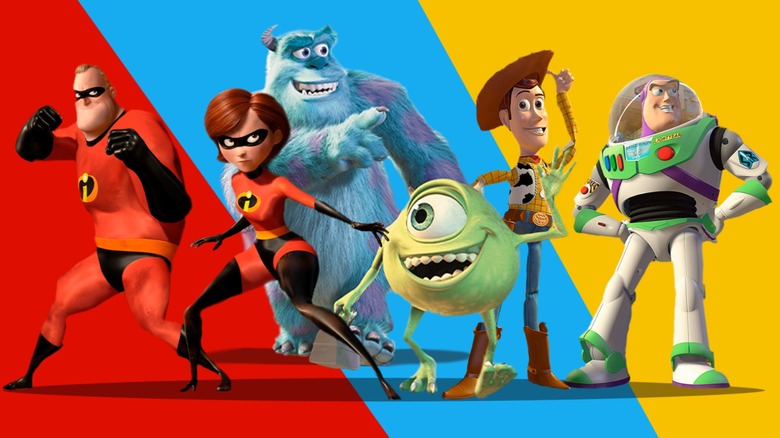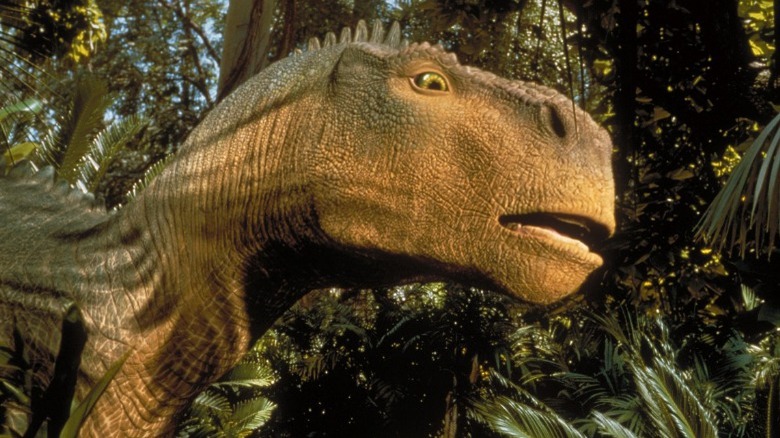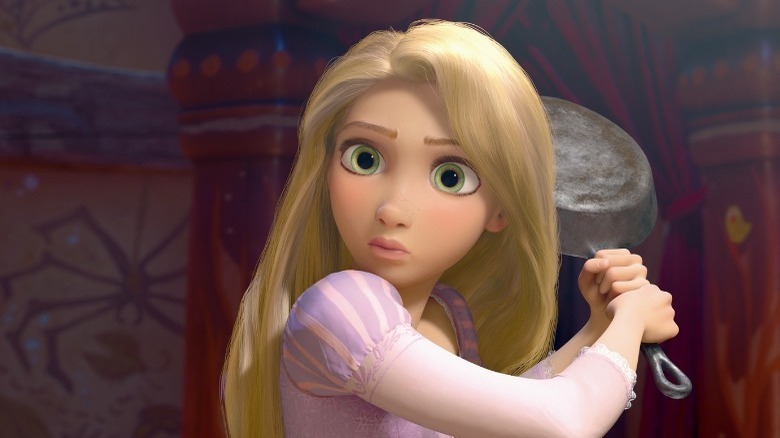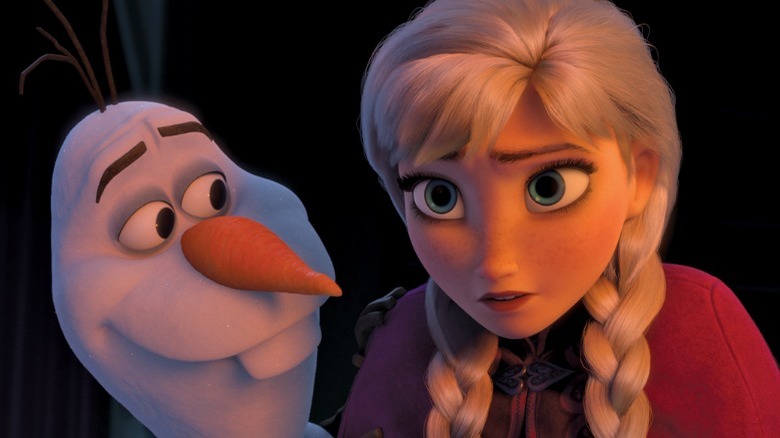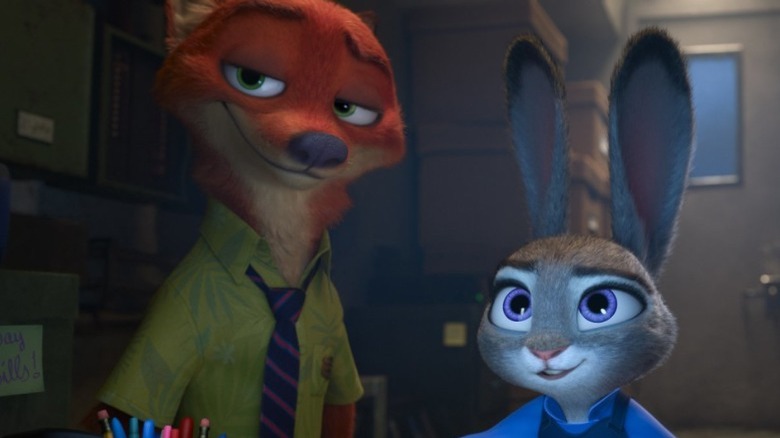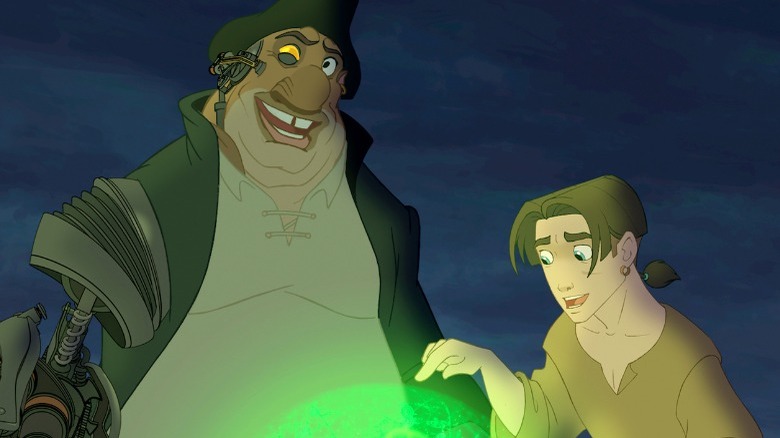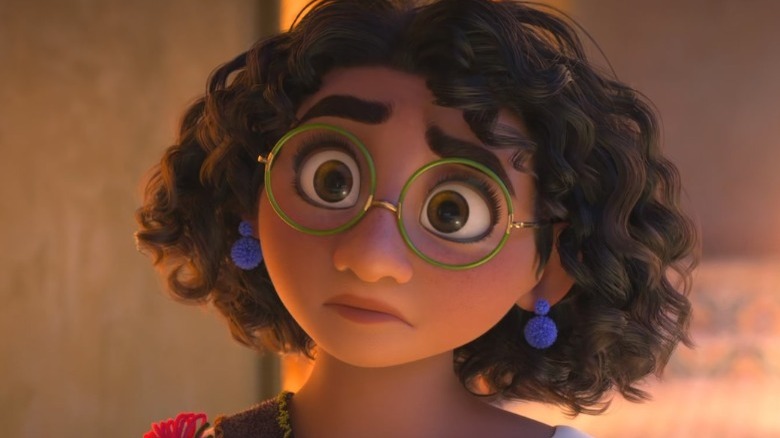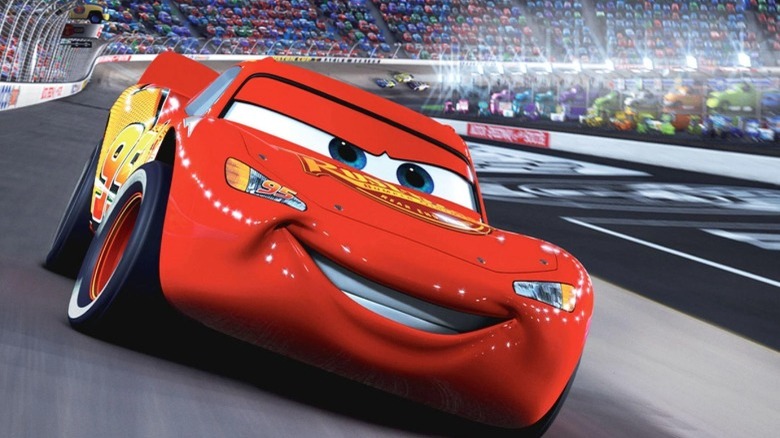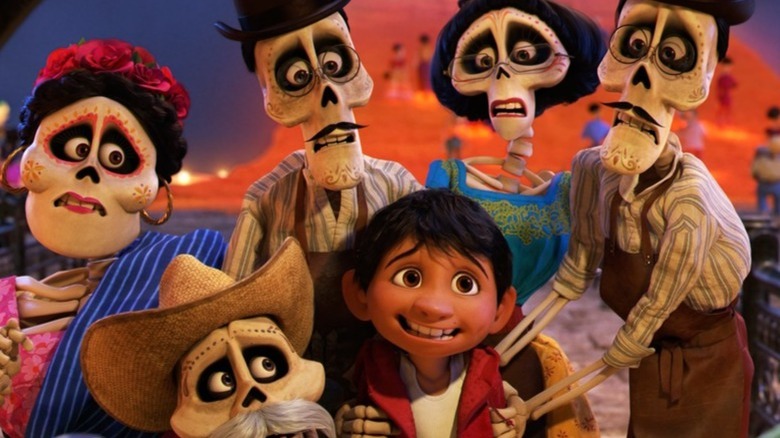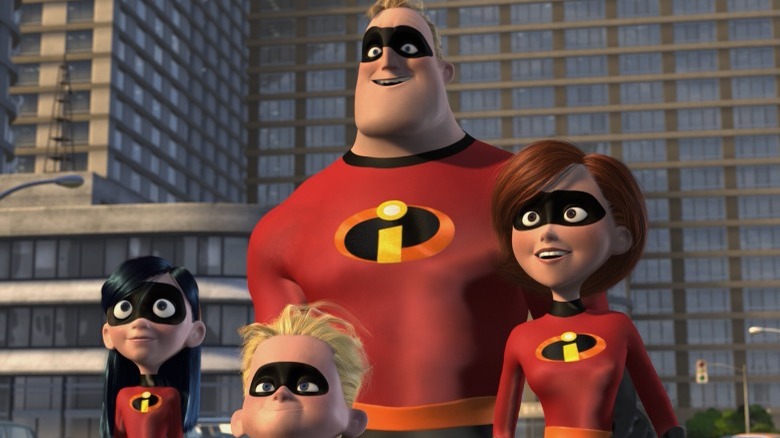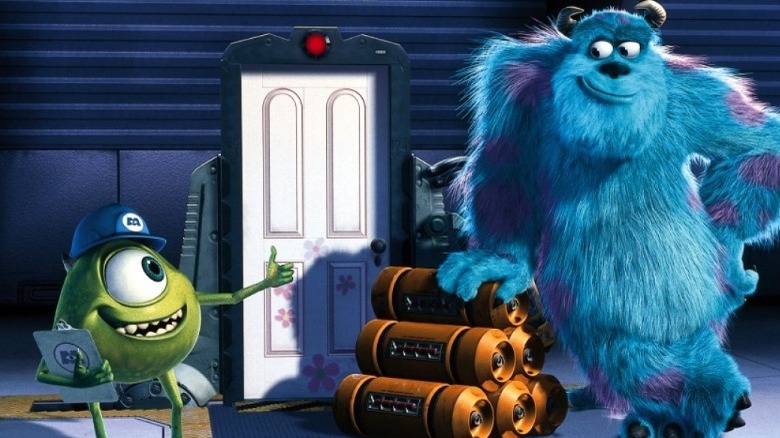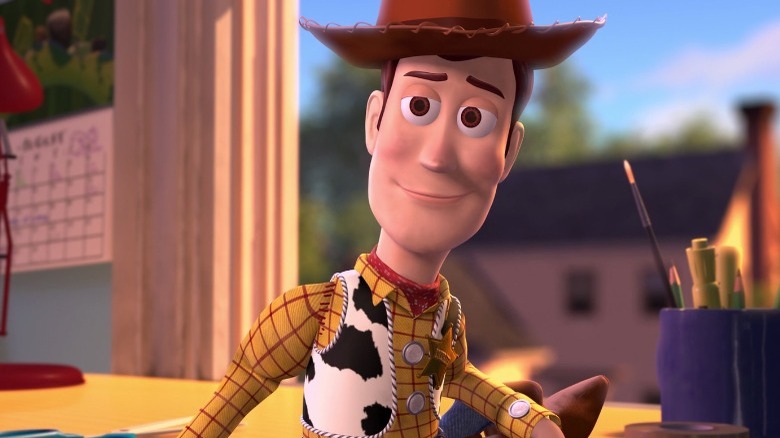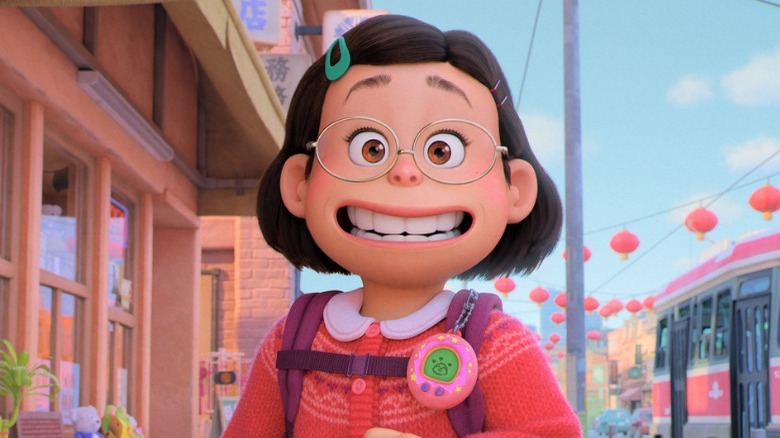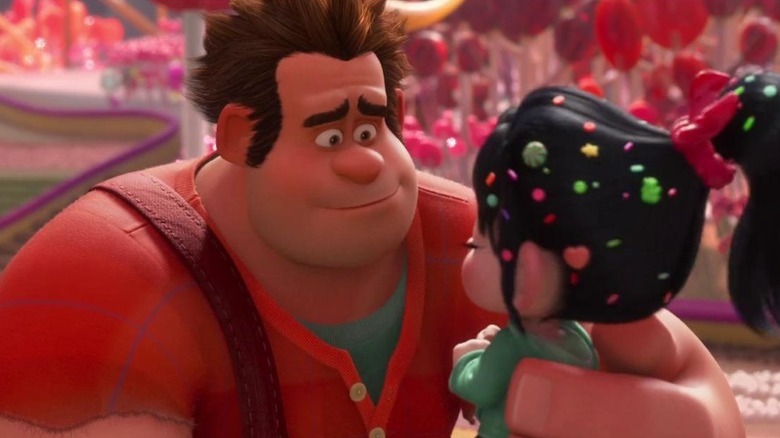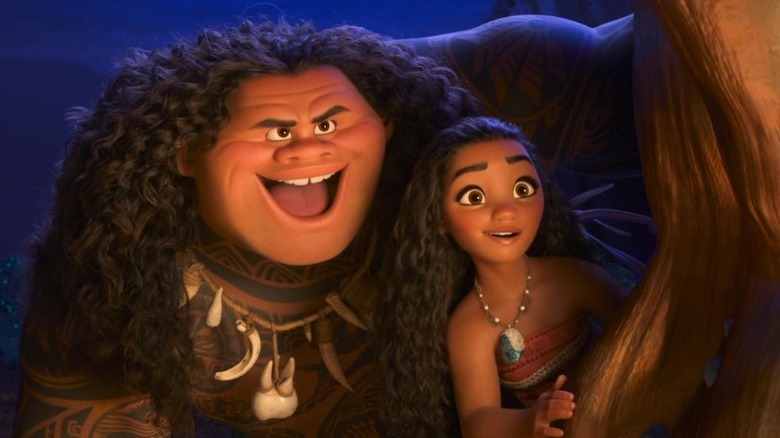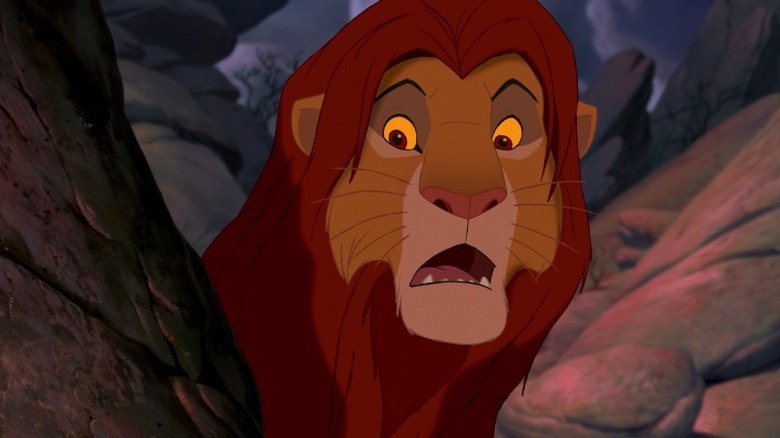Alternate Disney Movie Storylines That Could Have Changed Everything
Disney has been responsible for many of the best loved and most successful movies throughout Hollywood's long history. Most associated with animated pictures, the company's collaboration with Pixar has only strengthened its position and reputation as a creator of quality animation. With all that success, you might think that it's an easy task for the various directors, writers, and animators at Disney to draw on the studio's past and create these amazing stories. But that simply isn't the case.
Creating any film is a difficult task, and animated projects can often take several years to complete. In fact, it's not all that unusual for an idea to not start production until a decade after it was initially pitched. During that time, through the process of storyboarding the plot and fine-tuning the characters, movies go through extensive narrative changes that can see the story experience significant modifications. This can even happen quite far along in development, with last minute changes made to try and make the plot more cohesive or appealing.
Here's what some of your favorite Disney movies might have looked like if their stories weren't altered during production.
Dinosaur
Less remembered today than many of its contemporaries, "Dinosaur" is a 2000 film that follows the journey of a young Iguanodon named Aladar (D. B. Sweeney) who's abandoned when his nest is destroyed by a rampaging Carnotaurus. Raised by giant lemurs on a remote island, Aladar and his adopted family are forced to join a wandering herd of dinosaurs when a meteor shower hits their home. Chased by a series of predators and facing the wrath of the herd's leader, Aladar tries to find safety in a dangerous world.
The original premise for "Dinosaur" was that it would be a far more brutal and dark film that provided a realistic depiction of what life would have been like for these ancient creatures. More akin to a nature documentary, the story would even have ended with the entire cast of characters being killed as a result of the K–T extinction event (via Cinefantastique). According to SyFy, the movie would have been ultra-violent and an accurate representation of how dinosaurs lived, with no songs or talking creatures at all. By the time Disney had greenlit the project, it had shifted to become a more typical family animated adventure.
Tangled
With a reported budget of $260 million according to Box Office Mojo, 2010's "Tangled" may well be the most expensive animated film of all time. It's based on the fairy tale "Rapunzel," following the long-haired girl (Mandy Moore) who's been locked away in a tower in complete isolation and yearns to see the outside world. Although it features some new characters and a modern sense of humor, it's a fairly accurate retelling of the original story. "Tangled" ultimately went on to win critical acclaim and receive numerous award nominations.
When it was first pitched, the film went under the title "Rapunzel Unbraided" and was envisioned as a twist on the fairy tale format in the same style as "Shrek." According to Warped Factor, the plot would have revolved around a young couple living in modern-day San Francisco who find themselves magically transported to the fairy tale world where they take over the roles of Rapunzel and the prince.
In an interview with Movie Mom, the film's original director and executive producer Glen Keane explained that this version was good but didn't quite resonate as much as the established story. "It was a fun, wonderful, witty version and we had a couple of great writers," Keane explained. "But in my heart of hearts I believed there was something much more sincere and genuine to get out of the story, so we set it aside and went back to the roots of the original fairy tale.
Frozen
Out of all of Disney's recent animated films, "Frozen" stands out as the most successful. Not only was it a runaway box office hit, but it also won critical acclaim and launched an entire media franchise based on the characters of Elsa (Idina Menzel), Anna (Kristen Bell), and Olaf the snowman (Josh Gad). Set in the fictional world of Arendelle, the story follows sisters Princess Elsa and Anna as they grow apart due to Elsa's magical ability to control snow and ice. She ultimately exiles herself but is brought back to end the eternal winter of her home and is forced to battle with the evil Hans as he tries to take the throne for himself.
It's no surprise that the movie underwent a lot of evolution, especially considering that "Frozen" had a 70-year journey to the screen that began with Walt Disney's interest in adapting Hans Christian Andersen's "The Snow Queen." One story treatment would have seen Elsa take on more of a villainous role, acting as the primary antagonist in the film. Entertainment Weekly spoke to producer Peter Del Vecho who explained how Elsa was a Snow Queen who created an army of snow creatures to invade the kingdom. The two sisters would also not have been related, but Elsa would have ultimately been redeemed. Director Jennifer Lee also revealed that she wanted to kill off Olaf early in the story but was convinced against doing so (via Variety).
Zootopia
2016's "Zootopia," helmed by Byron Howard and Rich Moore, introduces a world filled with anthropomorphic animals living in harmony together. Much of the action follows police officer Judy Hopps and con artist Nick Wilde, voiced by Ginnifer Goodwin and Jason Bateman, as they unravel a mysterious conspiracy involving predators being turned feral as part of a plan for sheep Dawn Bellwether (Jenny Slate) to become mayor.
One of the earliest drafts for "Zootopia" was more of a James Bond parody, with the main character being a rabbit known as Jack Savage who leaves the animal city to investigate dangerous sea creatures. Less than two years before the movie released, the story was changed focus to a plot that involved predators being forced to wear shock collars to prevent them from feeling primitive urges that could lead to them hurting other animals. According to The Mary Sue, Disney executives felt this world was too dark to set the stage for a successful family film, and the narrative was modified to have a lighter tone.
Treasure Planet
"Treasure Planet" arguably has one of the most complicated histories of any Disney animated film in history. Masterminded by the creative force of John Musker and Roy Clements, who had previously directed "The Little Mermaid," "Aladdin," and "Hercules," it was essentially a retelling of "Treasure Island" in space. A teenage Jim Hawkins, voiced by Joseph Gordon-Levitt, joins up with the cyborg John Silver (Brian Murray) as they set out to find the legendary Treasure Planet by following a holographic map that Jim has stumbled upon.
Trying to modernize "Treasure Island" in a space setting was a difficult task, with co-writer Rob Edwards telling the BBC that the team faced many challenges that affected the development of the movie. This involved making Jim older to try and appeal to a wider audience, while the idea of traditional spaceships were removed early on in production. Writer Terry Rossio was particularly adamant that this change had a negative effect, writing for Wordplay that the team should have left Jim as a younger child to keep the story feeling dramatic.
Encanto
"Encanto" not only spawned some of the most memorable Disney songs of the last decade, but it also told an emotional and heartfelt story. The plot follows a magical Colombian family known as the Madrigals. Each of the members has their own special powers, and they all live together in their home of Casita. However, when Mirabel (Stephanie Beatriz) discovers her family's power is beginning to fade, she sets out to save her family and restore their power.
What audiences eventually got to see when "Encanto" was released could have been very different. Screen Rant reports that early drafts suggested that the action would take place over several generations of the Madigral family, spanning hundreds of years in total. Another version would have seen Agustín (Wilmer Valderrama) take on the role of the family patriarch, while the character we'd eventually know as Bruno (John Leguizamo) was named Oscar and acted more as a companion to Mirabel (via Empire Online).
Cars
"Cars" might not be held in the same regard as some of Pixar's other releases, but it's still an excellent film that was both a critical and financial success. The plot focuses on the adventures of Lightning McQueen, voiced by Owen Wilson, a hotshot anthropomorphic car who's trying to make a name for himself as a racer. After getting stranded in a small town on the way to his most important race yet, he learns there are more important things in life than simply winning.
In its original form, "Cars" was actually known as "The Yellow Car" and had a notably different story. The Huffington Post reported that the idea was first pitched as the release of "A Bug's Life" was approaching, with the plot centering on a cute electric car from overseas attempting to live in a world filled exclusively with gas-fueled vehicles. This take, loosely inspired by the fairy tale "The Ugly Duckling," was dropped after Pixar shelved the project to work on "Toy Story 2" and then made significant changes when the team began working on the production again.
Coco
2017's "Coco" is a bittersweet film that sees a young boy named Miguel (Anthony Gonzalez) who's transported to the Land of the Dead, where he must work with his long-dead ancestors to return to the world of the living and once again allow his family to enjoy music. Winning widespread critical acclaim, "Coco" was also a box office success and brought in more than $800 million in worldwide gross. Noted for its portrayal of Mexican culture, it's almost unrecognizable compared to the groundwork laid for its original form.
In an interview with The Verge, director Lee Unkrich confirmed that the first draft of "Coco" would have seen an American boy learning about his Mexican heritage following the death of his mother. While still influenced by the Day of the Dead holiday, it would have been an outsider's perspective of Mexico.
"Our first stab at the story reflected the fact that none of us at the time were from Mexico," Unkrich explained, "so it made sense to tell it from an outside perspective, because I knew we were going to have to teach the audience about the traditions, and about Mexico, and that seemed like a logical way to do it initially."
The Incredibles
"The Incredibles" is unusual for a Pixar film in that it focuses on an entirely human cast of characters. The 2004 release is the story of a superpowered family, made up of retired heroes Bob (Craig T. Nelson) and Helen (Holly Hunter), and their children Violet (Sarah Vowell), Dashiell (Eli Fucile), and baby Jack-Jack. Although the law demands they hide their special abilities, they become embroiled in a fight against Syndrome (Jason Lee), a former fan of Mr. Incredible who uses his scientific expertise to give himself powers and become a supervillain.
While Syndrome is the big bad of "The Incredibles," this was not always the case. Syndrome was initially designed only to be a minor bad guy, someone who would battle the family — then known as the Smiths — at the beginning of the film and then die in a subsequent explosion. The superheroes would then have fought a different primary antognist called Xerek. According to CBR, Syndrome was so popular among the crew that Xerek was moved aside to give him a more prominent role.
Monsters, Inc.
Starring the voices of John Goodman and Billy Crystal, "Monsters, Inc." is a 2001 animated film from Pixar that tells the story of James P. "Sulley" Sullivan and Mike Wazowski. The pair of monsters work at a factory that specializes in producing energy from the screams of young humans. This sees Sulley and other monsters travel through mysterious doors that transport them to children's bedrooms, where they can then scare the kids and capture the energy. When a young girl called Boo manages to escape her room, she causes havoc throughout the monster world as they believe her to be toxic.
An early version of the story that would become "Monsters, Inc." dealt with a grown man trying to overcome the fears caused by monsters he saw and sketched as a child (via Cinematical). Another version would have seen Sully team up with one of the kids he was assigned to scare for a television series that provided entertainment to other monsters by terrifying young human children (via Cinema.com).
Toy Story
Launching Pixar as a major animation studio in 1995, "Toy Story" was the start of a worldwide franchise that continues to this day. Featuring the voice talent of Tom Hanks and Tim Allen, the story focuses on a group of toys that come alive when children are not playing with them. When a brand new toy, Buzz Lightyear, is introduced to the home, the old favorite Woody becomes jealous and this sets off a chain of events that sees them eventually become friends.
What we know and love as "Toy Story" today initially started out as a continuation of Pixar's early short film "Tin Toy," and would have featured the wind-up Tinny along with a ventriloquist's dummy (via CBC). These characters were eventually replaced with Woody and Buzz, but the pair still had a long way to go to reach their final versions. Woody in particular was a far nastier figure who bullied the other toys (via Time). Rather than accidentally knocking Buzz out of the window, he actively tried to murder him by purposely throwing him out.
Turning Red
"Turning Red" made Pixar history in 2022 as the studio's first film to be solo directed by a woman, with Domee Shi helming the project following the success of her short film "Bao." Featuring a voice cast of Rosalie Chiang, Sandra Oh, and Maitreyi Ramakrishnan, it takes place in the Canadian city of Toronto. Due to a curse that has plagued her family for generations, Chinese Canadian protagonist Mei has to try and cope with the fact that she transforms into a huge red panda when she becomes emotional.
According to Insider, "Turning Red" might not have been recognizable as the same film if certain changes had not been made during development. For example, there was at one point a cousin of Mei's named Leo who could also transform into a panda, with Leo having just as big a role as the young female protagonist. This cousin was ultimately dropped as a major character because director Shi thought it took away from the original pitch that was about a young girl experiencing difficulties as she went through puberty.
Wreck-It Ralph
Released in 2012, "Wreck-It Ralph" is one of the more successful Disney films of recent years, even spawning a sequel in 2018 with "Ralph Breaks the Internet." The story focuses on Ralph, voiced by John C. Reilly, who is a villain in the fictional arcade game "Fix-it Felix, Jr." but is dissatisfied with his role and wants to prove that he's worthy of respect. While attempting to win a medal in another game, he encounters Sarah Silverman's Vanellope and Jane Lynch's Sergeant Tamora as he tries to help the youngster win a race in "Sugar Rush."
When laying the groundwork for "Wreck-It Ralph," director Rich Moore and the writing team had Felix as the protagonist who didn't want to follow in his father's footsteps and rebelled to find his own role (via Huffington Post). There was also a storyline in which Ralph, Felix, and Vanellope would travel through different games trying to fix her kart, while an entire sequence with Ralph becoming depressed and getting trapped in a hedonistic land known as "Extreme Easy Living 2" was also scrapped.
Moana
Helmed by the legendary duo of John Musker and Roy Clements — who had previously directed the likes of "The Little Mermaid," "Aladdin," and "Hercules" — "Moana" is a 2016 movie set in ancient Polynesia which sees a young girl named Moana (Auli'I Cravalho) and a demigod called Maui (Dwayne Johnson) set off on an adventure to save her island from a curse that threatens to destroy it by returning an ancient relic to Te Fiti.
According to IGN, early drafts of "Moana" didn't have any grandmother figure. She was only added at the suggestion of producer John Lasseter as a way of connecting the protagonist with the ancient culture of her family. Musker and Clements revealed to The Hollywood Reporter that during early production, Moana was also the only female in her family and this played an important role in the narrative as motivation to go out and explore to prove herself. Meanwhile, Maui started as a despondent character who had been trapped on an island for a millennium, far from the jovial energy Dwayne Johnson would eventually bring to the role.
The Lion King
The 1994 film "The Lion King" was one of the blockbusters that reestablished Disney as a major presence for a new generation, following on from the success of "The Little Mermaid" and "Beauty and the Beast" as part of the Disney Renaissance. Having earned almost a billion dollars at the box office, it starred the voices of Jonathan Taylor Thomas and Matthew Broderick as Simba as the hero grew to adulthood. Forced into exile after the death of his father, the young lion is raised by meerkat Timon (Nathan Lane) and warthog Pumbaa (Ernie Sabella), and later returns to Pride Rock to defeat his evil uncle Scar (Jeremy Irons).
That's the story that fans got to see when the movie arrived in cinemas. But the film actually went through a lot of story changes throughout production, and could have looked very different from the tale that audiences love to this day. Disney Theatrical Group president Tom Schumacher told MTV in 2017 that the original plan was to have Scar raise Simba himself. Having orchestrated events to get rid of Mufasa, the evil lion would have also attempted to murder his nephew but been prevented by the rest of the pride arriving. Schumacher also revealed that this is the reason Broderick was cast as Simba, as the character would have been a Ferris Bueller-type figure who spent his days goofing around.
